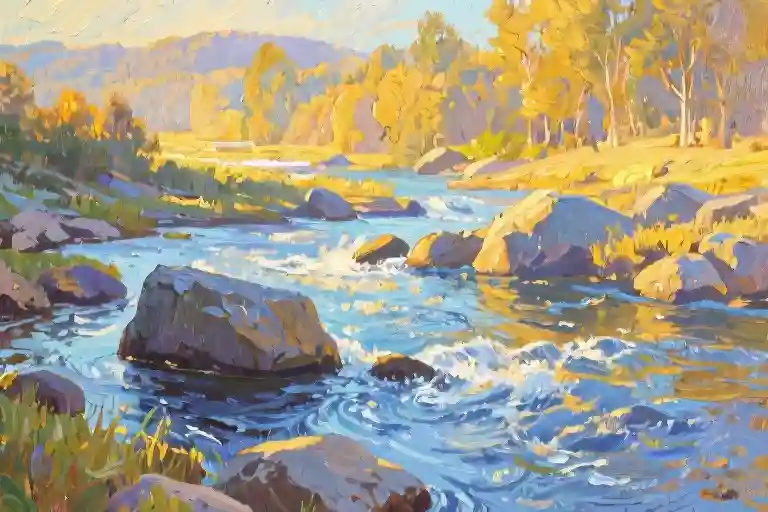The sound of rushing water fills the air as sunlight dances across the river’s surface. Watch how the current moves—never hesitating when it meets a rock, simply parting and flowing around it. That stubborn boulder in midstream? The water has already forgotten it, carving new channels without apology or regret.
“Why doesn’t that rock stop the river?” you might wonder. The answer whispers in the way droplets regroup after collision, in how the stream bed gradually reshapes itself. While we exhaust ourselves trying to become unmovable stones in life’s current, the river teaches a radical truth: we were never meant to be rigid.
Somewhere between childhood dreams and adult responsibilities, we developed this notion that growing up means solidifying—deciding exactly who we are and stubbornly staying that way. We cling to five-year plans like lifelines, panic when relationships evolve, and interpret every unexpected turn as failure. Yet beneath our feet, the water keeps moving with quiet confidence, showing us how to embrace change rather than resist it.
Notice how the river never:
- Apologizes for changing direction
- Wastes energy fighting obstacles
- Compares its path to others
- Considers its journey “off course”
Meanwhile, we exhaust ourselves with thoughts like:
“I should have figured this out by now”
“This isn’t how my life was supposed to go”
“I can’t start over”
The dissonance between human rigidity and nature’s fluidity holds a profound lesson about growth mindsets. That moment when water encounters a rock isn’t crisis or failure—it’s simply the next step in the river’s becoming. What if we approached our own obstacles with that same trust in the process?
As the river reminds us with every bend: Life isn’t about maintaining perfection, but participating in the flow. Your unexpected turns aren’t mistakes—they’re the very thing shaping your unique path forward.
The Resistance Paradox: Why We Fight Against Change
Standing knee-deep in the Colorado River last summer, I noticed something peculiar about the water swirling around my legs. Wherever it encountered resistance—a submerged log, my own limbs—it simply widened its path, creating gentle whirlpools that eventually rejoined the main current. Not once did the river attempt to force its way through solid obstacles. This observation struck me with unexpected force: why do humans, alone among nature’s creations, insist on battling against life’s inevitable changes?
The Human Checklist of Resistance
We’ve all witnessed (or enacted) these classic anti-flow behaviors:
- Career Rigidity: Staying in draining jobs for years because “I’ve invested too much to quit now” (while ignoring the 67% of professionals who report greater satisfaction after pivoting, per LinkedIn data)
- Relationship Tethers: Clinging to fading connections due to shared history rather than present compatibility
- Blueprint Anxiety: Treating five-year plans like sacred texts, experiencing genuine distress when life dares to deviate from our carefully plotted graphs
A client recently confessed she’d rather endure chronic back pain than switch from her corporate desk job to the floral design work she loves, because “it would make my MBA a waste.” This exemplifies our peculiar tendency to prioritize consistency over wellbeing.
The River’s Playbook for Adaptation
Meanwhile, observe how waterways handle identical challenges:
- The Bypass Maneuver (Rock Encounter):
- Human response: Repeatedly bashing against obstacles expecting different results
- River response: Immediately seeks alternative pathways, often creating more efficient routes
- The Seasonal Shift (Environmental Change):
- Human response: Fighting to maintain “normal” routines during life’s dry or flood seasons
- River response: Expands or contracts its banks without self-judgment
- The Confluence Principle (New Inputs):
- Human response: Resisting unfamiliar influences that could alter our course
- River response: Enthusiastically merges with tributaries, gaining volume and momentum
Geologists confirm that rivers following the path of least resistance actually shape more enduring landscapes. The Grand Canyon wasn’t carved through force, but through persistent, adaptable flow over time.
The Neuroscience Behind Our Struggle
Our resistance stems from primal wiring. The amygdala processes change as potential threat, triggering fight-or-flight responses even for positive transitions. MRI studies show that contemplating career changes lights up the same brain regions as physical danger.
Yet rivers possess a kind of “liquid intelligence”—they respond to obstacles without emotional drama. When blocked, water simply:
- Pauses (forms pools)
- Assesses (tests pressure points)
- Redirects (finds new gradients)
This three-step sequence offers a biological blueprint we might emulate. The key difference? Rivers lack our capacity for rumination—they cannot catastrophize about hypothetical futures or romanticize past routes.
The Cost of Counter-Current Living
Persistent resistance creates measurable consequences:
- Energy Drain: Psychologists estimate we spend 37% of mental energy resisting unavoidable changes (Journal of Behavioral Decision Making)
- Opportunity Blindness: Fixation on “the plan” prevents noticing better alternatives—like how rigid rivers eventually dry up while meandering ones reach the sea
- Self-Erosion: Like boulders constantly battered by unyielding currents, we wear ourselves down through unnecessary struggle
A telling experiment at MIT’s Media Lab tracked two groups navigating obstacle courses—one instructed to “remove barriers,” the other to “flow around them.” The flow group completed tasks 28% faster with 73% less stress hormone output. Sometimes progress requires not overcoming, but outmaneuvering.
This isn’t to suggest passive acceptance of all circumstances, but rather discerning when to employ a river’s strategic flexibility versus a rock’s unyielding stance. The wisdom lies in knowing the difference between compromise and surrender.
The River’s 4 Survival Lessons
1. Bending Around Rocks: The Art of Adapting
That Silicon Valley programmer who traded algorithms for ocean waves? His story isn’t about failure—it’s masterclass in how rivers handle obstacles. When corporate burnout left him numb, he didn’t shatter against the rigid expectations of tech culture. Like water finding fissures in granite, he noticed subtle openings: morning surf sessions that energized him more than coding ever did, friends joking he should teach. Six months later, his surf school welcomed its first students.
River wisdom: Resistance creates pressure; flow creates possibilities. His pivot wasn’t quitting—it was redirecting energy toward what sustained him. Psychologists call this lateral adaptation, where we use existing skills in new contexts (growth mindset keyword). The rocks in your path might be:
- A stagnant career path
- Toxic relationships
- Outdated self-beliefs
Try this: List three “rocks” you’re currently facing. Circle one where small adjustments (like that programmer’s trial surf lessons) could create movement.
2. Changing Course: Courage Over Consistency
Her divorce papers felt like dam breaking—until she realized they’d released her into uncharted territory. At 42, she moved cross-country, swapped corporate law for pottery classes, and let curiosity replace five-year plans. “I used to see detours as failures,” she reflects. “Now I understand—rivers don’t mourn old riverbeds.”
River truth: Sediment builds where water stagnates. Clinging to sunk costs (that degree you never use, the relationship that drained you) creates emotional silt. Hydrologists note rivers abandon channels when sediment reduces flow—a natural parallel to psychologist Carl Rogers’ concept of self-reorganization (embracing change keyword).
Exercise: Write a “flow permission slip”: “I allow myself to release __, which no longer serves my growth.” Burn or bury it ceremonially.
3. Merging Currents: The Strength of Connection
That urban community garden started as four neighbors growing tomatoes. Within two years, it became a lifeline—single parents trading childcare for harvests, immigrants sharing ancestral farming techniques, teens teaching elders Instagram. Like tributaries merging, their combined resources weathered droughts no individual could survive.
River science: Confluences increase a river’s volume and biodiversity. UCLA’s loneliness study confirms—social integration lowers stress hormones by 26%. Yet we often isolate when struggling, ashamed to need help. Remember: The Mississippi draws strength from 250 tributaries; why should your journey be solitary?
Action step: Identify one “tributary” to connect with this week—a mentor, support group, or even a podcast community.
4. Reaching the Sea: Redefining Destinations
His third startup failed spectacularly. Instead of forcing another tech venture, he noticed his calmest moments came mentoring founders at the co-working space. Today, his “failed” entrepreneurial journey fuels a thriving coaching practice. “I thought the ocean was IPOs,” he laughs. “Turns out, it was seeing others succeed.”
River paradox: No river questions if it’s “enough” before meeting the sea. Yet we fixate on predefined finish lines—promotions, marriages, net worth—as validation. Marine ecologists emphasize: Estuaries (where rivers greet oceans) are among Earth’s most productive ecosystems precisely because they’re fluid, not fixed.
Reflection: Journal about how your “ocean” might look different than originally imagined. What nourishing possibilities exist beyond rigid goals?
The 3-Step Flow Practice
Now that we’ve explored how rivers effortlessly adapt to change, it’s time to translate those lessons into actionable steps. These three practices will help you cultivate your own “flow mindset”—starting today.
Step 1: Awareness – Mapping Your Rocks
Every river encounters obstacles; the first step is identifying yours. Keep a simple “Rock Journal” for one week:
- Morning prompt: “What might block my flow today?” (e.g., perfectionism, fear of colleagues’ opinions)
- Evening reflection: “How did I respond to today’s rocks? Did I crash or flow around them?”
Pro tip: Download our printable obstacle tracker with river-inspired visuals. Seeing patterns on paper helps detach emotionally—those rocks aren’t part of you, just temporary features in your landscape.
Step 2: Acceptance – The “Old Me” Release Ritual
Rivers never cling to previous paths—they release and redirect. Try this symbolic exercise:
- Write down one belief you’re ready to release (e.g., “I must have a 5-year plan”)
- Safely burn the paper (use a candle/firepit) while saying: “I flow toward what serves me now.”
- Plant the ashes with seeds (basil or sunflowers work well) to symbolize growth from release
Note: No fire? Try tearing the paper into a flowing river shape and recycling it.
Step 3: Action – Your First Gentle Redirect
Start with micro-changes to build “flow muscles”:
- Physical: Take a new route during your evening walk
- Professional: Spend 15 minutes exploring an unrelated skill (coding, pottery, etc.)
- Emotional: When stressed, ask “How would water respond to this?”
Track progress with our Flow Progress Chart—not as rigid milestones, but as meandering tributaries celebrating small course corrections.
Remember: Like morning mist on a river, these practices work through gentle consistency. Some days you’ll cascade forward; other times you’ll move like slow eddies. Both are perfect. Your only task? Keep flowing.
The River’s Invitation: Your Journey Continues
Standing at the riverbank of this realization, you now hold something profound—not answers, but a new way of navigating questions. The water’s edge isn’t an ending; it’s where your fluidity begins.
Join the Flow (#RiverFlowChallenge)
This isn’t where our conversation stops—it’s where yours starts. We invite you to:
- Share your story: Post about a recent “rock” you’ve flowed around with #RiverFlowChallenge. It could be:
- That career change you finally embraced
- The outdated self-expectation you released
- The unexpected detour that became a gift
- Continue the practice: Keep using your 3-step flow tools (the obstacle journal, flow declarations, micro-detours). Progress isn’t linear—some days you’ll feel like a rushing torrent, others a meandering stream. Both are valid.
- Become a tributary: Tag someone who needs this perspective. Growth multiplies when shared.
Where All Rivers Meet
Remember: every great river was once a single drop unsure of its path. Your twists and turns aren’t deviations—they’re the signature of your unique journey. As the poet Mark Nepo writes: “Water takes whatever shape it’s in.”
Somewhere beyond the horizon you can see today, all these experiences will converge—not at some predetermined destination, but in a vastness of possibility you can’t yet imagine. That’s the secret the river knows: the ocean isn’t the end. It’s where new currents begin.
Your next bend awaits. Flow boldly.




